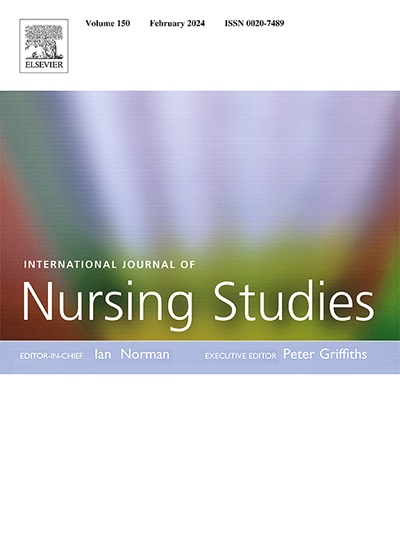Reminiscence therapy delivery formats for older adults with dementia or mild cognitive impairment: A systematic review and network meta-analysis
IF 7.1
1区 医学
Q1 NURSING
引用次数: 0
Abstract
Background
Reminiscence therapies are beneficial for people who have dementia or mild cognitive impairment and are widely used among older adults in service institutions and community health care. However, it is not clear which reminiscence therapy delivery format is the most effective.
Objectives
To evaluate all reminiscence therapy delivery formats with regard to comparative cognitive function, depressive symptoms, quality of life and adherence, among people with dementia or mild cognitive impairment.
Methods
Nine databases were searched systematically to screen pertinent randomized controlled trials (RCTs) published as of March 7, 2025. The effects of and adherence to reminiscence therapy delivery formats were ranked by using a network meta-analysis based on frequentist approaches. The inconsistency between direct comparison and indirect comparison was examined by the node-splitting method. The surface under the cumulative ranking curve (SUCRA) was calculated to rank probability of all reminiscence therapy delivery formats.
Results
Fifty-three RCTs involving 4582 participants were included from 4363 records. Compared to the control groups, reminiscence therapy improved cognitive function, reduced depressive symptoms and improved quality of life and this differed according to delivery format. Digital reminiscence therapy had better effects relative to treatment as usual (SMD = 5.02, 95 % CI: 2.57, 7.48) was the highest ranking (SUCRA = 93.6 %) for cognitive function. Digital reminiscence therapy had better effects compared to treatment as usual (SMD = − 5.98, 95 % CI: − 10.67, − 1.30) with highest ranking (SUCRA = 94.9 %) for depressive symptoms. Individual reminiscence therapy had better effects compared to treatment as usual (SMD = 5.15, 95 % CI: 3.61, 6.70) and ranked first (SUCRA = 98.3 %) for quality of life. Group reminiscence therapy was the best format compared to individual reminiscence therapy (SMD = 2.36, 95 % CI: 1.37, 4.06) and treatment as usual (SMD = 1.71, 95 % CI: 1.07, 2.73) with highest ranking (SUCRA = 95.6 %).
Conclusions
This review suggests that digital reminiscence therapy seems to be the most effective format for people with dementia or mild cognitive impairment and adherence is likely to be higher following group reminiscence therapy. Considering the limitations of this review, more comprehensive multi-group randomized controlled trials are warranted to compare the effects of and adherence to reminiscence therapy delivery formats for people with dementia or mild cognitive impairment.
Registration
This review was registered with PROSPERO (CRD42024530754).
老年痴呆或轻度认知障碍患者的回忆治疗方式:系统回顾和网络荟萃分析
背景回忆疗法对痴呆症患者或轻度认知障碍患者有益,在服务机构和社区医疗机构的老年人中广泛使用。方法系统检索九个数据库,筛选截至 2025 年 3 月 7 日发表的相关随机对照试验(RCT)。通过基于频数主义方法的网络荟萃分析,对回忆疗法的效果和坚持率进行了排序。采用节点分割法检验了直接比较与间接比较之间的不一致性。结果从 4363 条记录中选取了 53 项 RCT,涉及 4582 名参与者。与对照组相比,回忆疗法改善了认知功能,减轻了抑郁症状,提高了生活质量,而且不同的治疗方式效果也不同。相对于常规治疗,数字回忆疗法的效果更好(SMD = 5.02,95 % CI:2.57, 7.48),在认知功能方面的排名最高(SUCRA = 93.6 %)。与常规疗法相比,数字回忆疗法的效果更好(SMD = - 5.98,95 % CI:- 10.67,- 1.30),在抑郁症状方面的排名最高(SUCRA = 94.9 %)。与常规治疗相比,个人回忆疗法的效果更好(SMD = 5.15,95 % CI:3.61,6.70),在生活质量方面排名第一(SUCRA = 98.3 %)。与个人回忆疗法(SMD = 2.36,95 % CI:1.37,4.06)和常规疗法(SMD = 1.71,95 % CI:1.07,2.73)相比,集体回忆疗法是最好的形式,排名最高(SUCRA = 95.6 %)。考虑到本综述的局限性,有必要进行更全面的多组随机对照试验,以比较回忆疗法对痴呆症患者或轻度认知障碍患者的效果和依从性。注册本综述已在 PROSPERO 注册(CRD42024530754)。
本文章由计算机程序翻译,如有差异,请以英文原文为准。
求助全文
约1分钟内获得全文
求助全文
来源期刊
CiteScore
15.00
自引率
2.50%
发文量
181
审稿时长
21 days
期刊介绍:
The International Journal of Nursing Studies (IJNS) is a highly respected journal that has been publishing original peer-reviewed articles since 1963. It provides a forum for original research and scholarship about health care delivery, organisation, management, workforce, policy, and research methods relevant to nursing, midwifery, and other health related professions. The journal aims to support evidence informed policy and practice by publishing research, systematic and other scholarly reviews, critical discussion, and commentary of the highest standard. The IJNS is indexed in major databases including PubMed, Medline, Thomson Reuters - Science Citation Index, Scopus, Thomson Reuters - Social Science Citation Index, CINAHL, and the BNI (British Nursing Index).

 求助内容:
求助内容: 应助结果提醒方式:
应助结果提醒方式:


